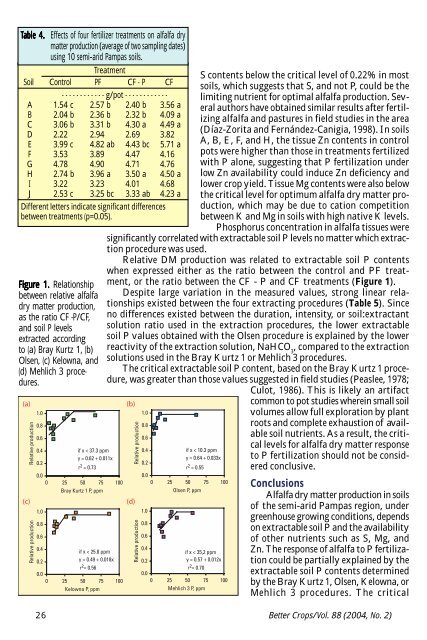Better Crops 2004 #2 - International Plant Nutrition Institute
Better Crops 2004 #2 - International Plant Nutrition Institute
Better Crops 2004 #2 - International Plant Nutrition Institute
Create successful ePaper yourself
Turn your PDF publications into a flip-book with our unique Google optimized e-Paper software.
Table 4. Effects of four fertilizer treatments on alfalfa dry<br />
matter production (average of two sampling dates)<br />
using 10 semi-arid Pampas soils.<br />
Treatment<br />
Soil Control PF CF - P CF<br />
- - - - - - - - - - - - g/pot - - - - - - - - - - - -<br />
A 1.54 c 2.57 b 2.40 b 3.56 a<br />
B 2.04 b 2.36 b 2.32 b 4.09 a<br />
C 3.06 b 3.31 b 4.30 a 4.49 a<br />
D 2.22 2.94 2.69 3.82<br />
E 3.99 c 4.82 ab 4.43 bc 5.71 a<br />
F 3.53 3.89 4.47 4.16<br />
G 4.78 4.90 4.71 4.76<br />
H 2.74 b 3.96 a 3.50 a 4.50 a<br />
I 3.22 3.23 4.01 4.68<br />
J 2.53 c 3.25 bc 3.33 ab 4.23 a<br />
Different letters indicate significant differences<br />
between treatments (p=0.05).<br />
Figur<br />
igure e 1. Relationship<br />
between relative alfalfa<br />
dry matter production,<br />
as the ratio CF -P/CF,<br />
and soil P levels<br />
extracted according<br />
to (a) Bray Kurtz 1, (b)<br />
Olsen, (c) Kelowna, and<br />
(d) Mehlich 3 procedures.<br />
S contents below the critical level of 0.22% in most<br />
soils, which suggests that S, and not P, could be the<br />
limiting nutrient for optimal alfalfa production. Several<br />
authors have obtained similar results after fertilizing<br />
alfalfa and pastures in field studies in the area<br />
(Díaz-Zorita and Fernández-Canigia, 1998). In soils<br />
A, B, E, F, and H, the tissue Zn contents in control<br />
pots were higher than those in treatments fertilized<br />
with P alone, suggesting that P fertilization under<br />
low Zn availability could induce Zn deficiency and<br />
lower crop yield. Tissue Mg contents were also below<br />
the critical level for optimum alfalfa dry matter production,<br />
which may be due to cation competition<br />
between K and Mg in soils with high native K levels.<br />
Phosphorus concentration in alfalfa tissues were<br />
significantly correlated with extractable soil P levels no matter which extraction<br />
procedure was used.<br />
Relative DM production was related to extractable soil P contents<br />
when expressed either as the ratio between the control and PF treatment,<br />
or the ratio between the CF - P and CF treatments (Figure 1).<br />
Despite large variation in the measured values, strong linear relationships<br />
existed between the four extracting procedures (Table 5). Since<br />
no differences existed between the duration, intensity, or soil:extractant<br />
solution ratio used in the extraction procedures, the lower extractable<br />
soil P values obtained with the Olsen procedure is explained by the lower<br />
reactivity of the extraction solution, NaHCO 3<br />
, compared to the extraction<br />
solutions used in the Bray Kurtz 1 or Mehlich 3 procedures.<br />
The critical extractable soil P content, based on the Bray Kurtz 1 procedure,<br />
was greater than those values suggested in field studies (Peaslee, 1978;<br />
Culot, 1986). This is likely an artifact<br />
common to pot studies wherein small soil<br />
volumes allow full exploration by plant<br />
roots and complete exhaustion of available<br />
soil nutrients. As a result, the critical<br />
levels for alfalfa dry matter response<br />
to P fertilization should not be considered<br />
conclusive.<br />
Conclusions<br />
Alfalfa dry matter production in soils<br />
of the semi-arid Pampas region, under<br />
greenhouse growing conditions, depends<br />
on extractable soil P and the availability<br />
of other nutrients such as S, Mg, and<br />
Zn. The response of alfalfa to P fertilization<br />
could be partially explained by the<br />
extractable soil P contents determined<br />
by the Bray Kurtz 1, Olsen, Kelowna, or<br />
Mehlich 3 procedures. The critical<br />
26 <strong>Better</strong> <strong>Crops</strong>/Vol. 88 (<strong>2004</strong>, No. 2)

















